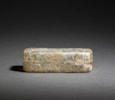Fatimid Pen Box
This fatimid glass pen box is created in colourless glass, a wheel-cut decoration is visible, although the decay of the glass over time has blurred its clarity. The two parts are of equal size, oblong in shape with rounded edges.
An exceedingly rare and unusual object, this glass box belongs to a very small group of similar containers of which, according to the Aga Khan Museum in Toronto, initially only three were known, though others have since emerged. One of the other boxes is in the Aga Khan Museum, Toronto, catalogued as from West Asia or Iran, 10th-11th century; another is in Berlin, in the Museum für Islamische Kunst, which was found in Egypt and is catalogued as 11th century Fatimid Egyptian. Both boxes have metal hinges, with which the box was opened, and it is possible that the current box also had such hinges, now lost. The box in Toronto displays similar wheel-cut decoration as the current box, which is claimed to point to an eastern origin, suggesting both may therefore have been worked in glasshouses in Iraq or Iran in the 10th and 11th centuries, when wheel-cut glass was produced in larger numbers. The third box is kept in the Cathedral Treasury in Capua, Italy and was used to house the relics of Saint Blaise. The metal hinges and clasp on the third box are not of Islamic origin and were probably added later.
Hommage à René Huyghe, Tessier & Sarrou et Associés, Paris, 5th June 2019, Lot 168.
Art De L’Islam et De L’Inde & Archéologie, Ader, Paris, 25th November 2021, Lot 170.
David Aaron Ltd, 2023, No. 14.
Previously in the Private Collection of René Huyghe (1906-1997), kept in an apartment on the rue Corneille, Paris, where he had lived since the 1960s.
Thence by descent to his son François-Bernard Huyghe.
Sold at: Hommage à René Huyghe, Tessier & Sarrou et Associés, Paris, 5th June 2019, Lot 168.
Private Collection, France, acquired from the above sale.
Sold at: Art De L’Islam et De L’Inde & Archéologie, Ader, Paris, 25th November 2021, Lot 170.
Acquired from the above sale.
ALR: S00219034, With IADAA certificate, this item has been searched against the Interpol database.
René Huyghe (1906-1997) was a French writer, philosopher, and curator. From 1930 he was curator of the Louvre's department of paintings, rising to chief curator and professor of the école du Louvre in 1936, aged only 30. He founded and edited the reviews L’Amour de l’Art and Quadrige, was one of the first figures in France to make films on art, such as his Rubens (winner of a prize at the Venice Biennale), and founded the International Federation of Films on Art.
He was instrumental during the Second World War in helping to organise the evacuation of the Louvre’s paintings into the unoccupied zone, taking charge of their protection until the end of the war.
In 1974 he was made director of the Musée Jacquemart-André. He was a professor at the Collège de France and member of the Académie Française, and published a philosophical discourse called Dawn After Dark with the Japanese philosopher Daisaku Ikeda










 Enquire
Enquire




